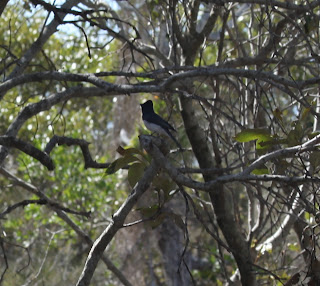The male crested shrike-tit
After returning from the farm trip, we had a quick 5-minute breakfast before going on the bus to the Gold Coast to look for waders, seabirds and mangrove birds. As the bus started up, I got a photo of a brown cuckoo-dove in one of the trees around the front of O'Reilly's.
The brown cuckoo-dove
We went down to the Gold Coast, where we departed on a small boat, to go out to the many sandy islets and spits in the Gold Coast's waters to look for waders, then to go to South Stradbroke Island for mangrove birds like the collared kingfisher and mangrove honeyeater. Almost immediately, we passed a sandbar with crested terns, pelicans and silver gulls on it, as well as a few little pied and pied cormorants. These were common birds throughout the trip. Someone with keen eyes spotted a striated heron on the other side of the river mouth.
After looking at the striated heron and some more terns and red-capped plovers, we stopped over at an island formerly known as 1 tree island. This island was currently hosting big flocks of terns and some waders. Though at first it seemed to me that all the terns were great crested terns, our guide Ian pointed out a few gull-billed and caspian terns with his scope on the island. The wader flocks were made up of only three species- whimbrels, eastern curlews and bar-tailed godwits. There were also pied oystercatchers, silver gulls and pelicans on the island. For a better view of these birds, we landed on the island, breaking my camera in the process. I managed to convince dad to let me use his camera, a big SLR.A cropped image of gull-billed and caspian terns
A flock of whimbrels, eastern curlews and bar-tailed godwits fly off
As the boat finally landed, we saw a pied oystercatcher on its nest. In one of the trees was an immature pied butcherbird. We walked on and used Ian's scope to look at the waders and terns from far away without scaring them away. We also saw an australasian pipit in the grassy center of the island. There were heaps of harmless blue jellyfish around the island, scattered amongst the sand and in the water. As we reached the boat, we saw a huge flock of little black cormorants and silver gulls feeding. We got back in the boat and headed for South Stradbroke, getting a look at flocks of common terns and little terns a long way away from the boat. The boat landed on the island. We walked around the beach where we had landed, looking for a pair of beach stone-curlews Ian said nested here. After failing to find them, we walked to a mangrove forest. In the forest of mangroves we saw far away grey-tailed tattlers, and a pair of rather tame bar-tailed godwits, as well as eastern great egrets and little egrets. After looking around for a while, Ian managed to get his scope on a mangrove honeyeater that was too quick for me to photograph.
The bar-tailed godwitsAfter looking at the honeyeater we went to the other side of the mangroves to try and see collared kingfishers and mangrove gerygones. We scanned the mangroves apprehensively. Then we heard a kingfisher call from nearby. It called again. Then we heard the three words. "I found it!" Ian quickly got a scope on it and I managed to take a lot of photos.
Collared kingfisher
After looking at that, we went over to another part of the mangrove swamp, where we saw a leaden flycatcher and an olive-backed oriole.
A male leaden flycatcher
Can you see the oriole?
We walked on from there, looking for the beach stone-curlews. We walked through a lot of the island, seeing the swamp wallabies which inhabited the island and a knobby dragon lizard. Finally, we stopped at a clearing and Ian whispered...
BEACH STONE CURLEW!
After returning to the mainland and driving back, we had dinner and went to sleep, ending a fabulous day full of new birds.










No comments:
Post a Comment